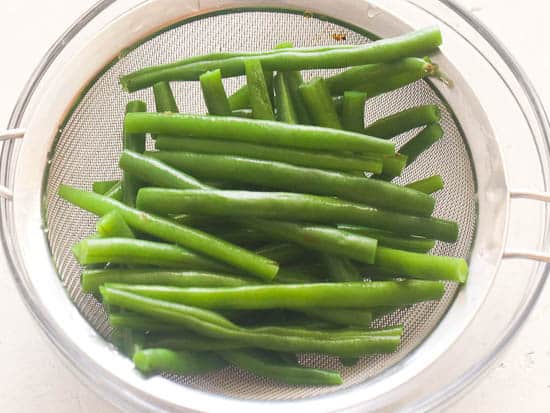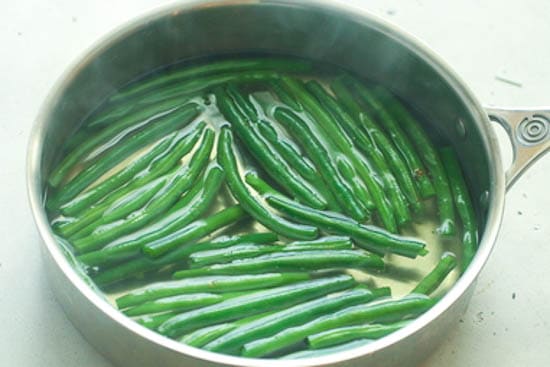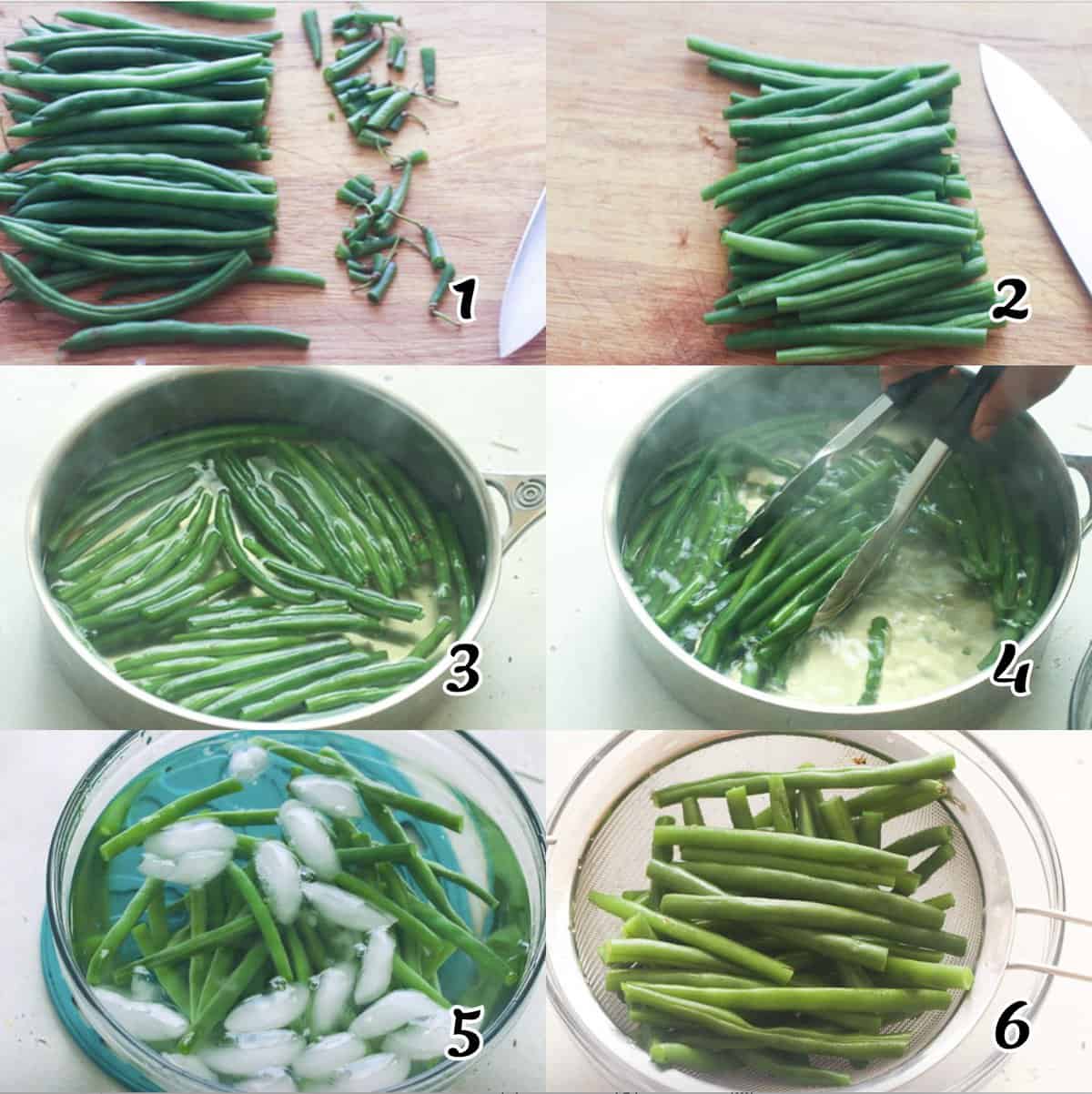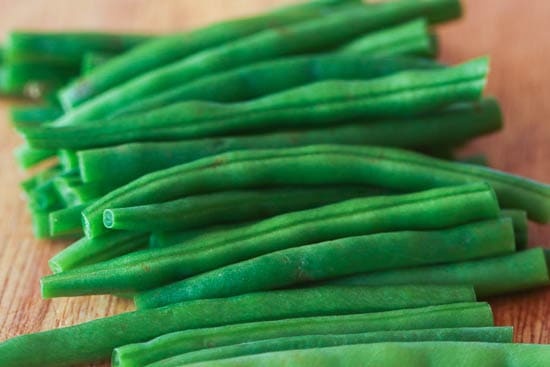How to Blanch Green Beans
How to Blanch Green Beans – Green beans are one of the easiest veggies to work with. They cook quickly, are naturally tasty, and are pleasantly crisp when blanched. Season them with salt and pepper, and you’ll have a deliciously healthy side dish in no time.
In Southern talk, a mess of green beans is when you have a bunch of them. What to do? That’s when a fail-proof technique to blanch green beans is a lifesaver, so you don’t waste nature’s bounty.
Blanching green beans is super fast and easy, so I wonder why I don’t do it more often. Besides being delicious, it improves the texture and taste to fit your dish. That and blanched veggies are ideal for the freezer.
Content…Why Blanching is Practical |
Why Blanching Green Beans Is Practical
Green beans (string beans or snap beans because they snap easily) are seasonal and best fresh. And when blanched, you can freeze them or add them to salads for a quick and healthy addition. They’re also delicious tossed last minute into sautés, stir-fries, roasted veggies, soups, stews, pasta, and salads. 😉
What You Need
- Green Beans – Choose green beans with a vivid green color and firm enough to easily snap. Also, check for damage and discoloration.
- Hot Water – You need boiling water to boil the green beans and achieve those crispy and tender bites! Crunch!
- Tools – A large pot that holds enough water to cover the green beans while cooking and a large bowl for the ice water bath will make the job a cinch.
- Ice Bath – Ice stops the cooking process fast, so the beans keep their gorgeous green color and crispness.
- Salt – This pantry-staple flavor enhancer (about one tablespoon per quart of water) also protects the beans’ beautiful color.
How to Blanch Green Beans
- Rinse – Place the green beans in a colander and rinse under running water, then give a shake to dry.
- Trim the ends easily by individually snapping off the non-edible ends or cutting off the tips of three or more green beans at the same time using a knife or kitchen scissors. Remove tough strings at the sides of the beans (if they have them). (Photos 1-2)
- Boiling Water – Pour about four quarts of water into a large pot. The pot should hold enough water to cover the green beans without boiling over. Add salt.
- Prep Ice Bath – While your water is coming to a boil, put ice cubes and water in a large bowl so you can put the beans in as soon as they come out of the boiling water.
- Cook – Add the green beans to the boiling water for 3-5 minutes until it’s tender-crisp and the color is bright green. (Photos 3-4)
- Transfer – When the desired color and texture are achieved, remove immediately from boiling water and transfer them to the ice bath. (Photo 5)
- Drain – Once the beans cool, drain them completely, and they are ready to use. (Photo 6)
Blanching Tips
- Keep an eye on the pot! Keep the green beans from cooking completely. Once the color becomes brighter, remove it immediately from the heat.
- Always trim and snap stem ends. Remove any tough strings for a more enjoyable experience.
- Wash with cold water and shake them dry.
- Boil the salted water first before adding green beans. This avoids overcooking and the beans from tenderizing before giving bright green color.
Storage Instructions
Storing fresh green beans is different from blanched green beans. Fresh green beans can be kept in an open bag in your fridge for up to seven days. Only wash them before using and not if you’re planning to store them longer, or else they may mold.
You can store blanched green beans in a ziplock bag and refrigerate them for one week or freeze them for nine months.
To flash freeze them, pat them dry and arrange them in a sheet pan with parchment paper in a single layer. Once they freeze solid, transfer them to an airtight bag or resealable bag.
Note: Don’t freeze unblanched green beans, or you’ll end up with dull and mushy green beans.
FAQs
For the best results, I recommend cooking the green beans in salted boiling water for 3-5 minutes. Longer than that may overcook the green beans, and they’ll turn a dull green.
There is no specific instruction when you want to freeze them. Just follow the instructions from the how-to and the storage instructions.
Blanching is done with boiling salted water. Thus, the green beans are blanched in hot water and plunged immediately into cold water to stop the cooking process.
How to Use Blanched Green Beans
If you want to use them, just thaw them and add them to anything you want. Some great recipes to throw them into are:
More Fantastic Green Bean Recipes to Try
- Green Beans and Bacon
- Bacon Wrapped Green Beans
- Green Bean Casserole
- Southern Green Beans and Potatoes
- Slow Cooker Chicken Curry
Conclusion
Say goodbye to overcooked green beans (or almost any veggie) with this easy blanching technique. Do you have other tips for blanching veggies? Let me know in the comments! 😉










